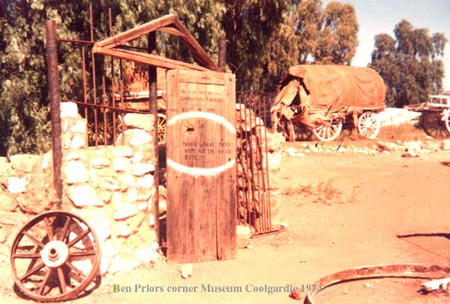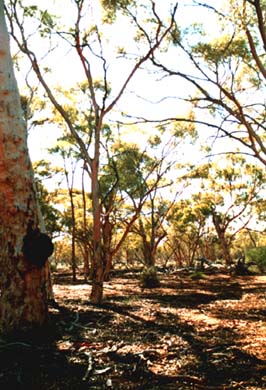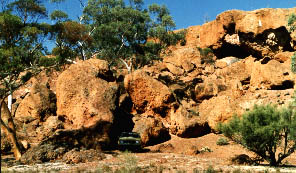 Coolgardie
CoolgardieHOME . . . . CAMPING . . . . . TRANSPORT . . . . . HEALTH . . . . . LOCATIONS . . . . . NEWS . . . . . FORUM . . . . . SAFETY
Coolgardie was a very different town in the early 1970's than today. There were still many remanents of the towns great mining past when I first arrived. Headframes were standing all over the place: most of the shafts were still open and relic's abounded. Bayley's mine was still largely intact although parts and much equipment had been removed for other batteries and 'shows' around the region.
Old Ben Prior gave me a good bit of the local history and allowed me to wander through the wealth of materials in his shop. The man was a great collector and my hope is that the treasures he left behind are associated, by their new owners, to Ben and his love of Coolgardie. In the photo above, you can see one of the old Studebaker wagons that Ben salvaged from around the area. These were the real deal: the same wagons of the wild west USA, brought here for the cartage of stores in the days before the railway. Ben Prior owned a fair bit of property around Coolgardie. He rented me my first house into which I moved with my young bride. He helped us on many occasions and I was sadened when I heard of his passing. I was never to meet his son.
I lived and worked around Coolgardie over several years. We saw many changes led by a general clean-up of the town in the name of progress. I would call it something else. One night the 'boarding house across from the Denver City hotel burnt down. It was a multi-story timber ex-pub that was gone completely in less than 30 mins; a spectacular blaze that shot sparks high into the night sky. Saving adjacent buildings from catching fire was a job well done . . . considering many of the volunteer fire brigade had been having a few coldies in the Denver city when the fire erupted.
One morning I heard a series of explosions coming from the area of Bayley's mine. I decided to 'wander over' and have a look. There was a Acco truck with a lift crane parked there. I went to see what was happening and discovered the driver loading scrap onto the back of the eight tonner. The old engine room was gone then but the cast iron blocks of the old motors had remained. These were examples of British Engineering that has seen no equal in recent years; they were huge bottom ends with the lower caps and crankcase in a cream- mottled, fired enamel. They were beutifull relic's of a by-gone age. The truck driver was just finishing loading the last of these onto the truck. He had placed explosives and blown them to bits. I chided him for a lack of 'history', he shrugged his shoulders and told me they were worth $170 a tonne. Things were hard during those days. Nickle was all the go and Kalgoorlie was firmly in decline. Still, it's a pity the short term needs of my generation removed many of these things and they are no longer in existence.
 Coolgardie
is a diverse envioronment of dry salt bush plains and rich forrest
areas. There are hill and gully's, breakaway country as well as afew
Granite outcrops of magnifiecent proportions both above and below
ground.
Coolgardie
is a diverse envioronment of dry salt bush plains and rich forrest
areas. There are hill and gully's, breakaway country as well as afew
Granite outcrops of magnifiecent proportions both above and below
ground.
 This breakaway is located to the north west of Coolgardie on a
station property. It is too far off the beaten track for most
tourists and permission should be sought before entering the
property. . . if you can find it. Perhaps contact the station in that
area for directions.
This breakaway is located to the north west of Coolgardie on a
station property. It is too far off the beaten track for most
tourists and permission should be sought before entering the
property. . . if you can find it. Perhaps contact the station in that
area for directions.
Victoria rock is located to the south of Coolgardie. It is an intersting granite outcrop well worth a picnic visit.
Coolgardie is such a huge area that I would suggest a visitor take the time to get local information and head-off using Coolgardie as a base. I was there fairly recently and the 'word' was that casual prospecting was discouraged. I did see a few semi-threatening signs about detecting around Tindals and the associated basin. There are great relic spots along the eastern slopes and hills across the railway bridge on Hunt Street, about a kilometre towards Burbanks. The mines department still had an office in Coolgardie last year and this is a good place to start.
Just another observation: when I first arrived here during the early 1970's, there were several aboriginal inhabitants living in camps around the town. Some of the elders would walk past my house on Hunt Street and go down to Burbanks to speck for gold. I watched them at work and the simple manner they went about specking really impressed me. They would stroll with their hands behind their backs, dressed is sports-coats, slacks and more often than not, thongs. Some wore brightly coloured beanies and blankets during the winter. They would walk as a wide group: a gentle pace all the while chatting in their own language. They would pick-up something from time to time and examine it, but they were very relaxed and certainly in no hurry. Mick. Moran, the storekeeper, told me they did quite well. I learned by their example, to take it slow when it came to prospecting, especially metal detecting. Those old blokes wore thongs because of the spread of Bind-eyes. Bindi-eyes are also called 'three corner jacks', an interesting name for the spikey seed-pod of a low growing weed that originated from South Africa. The spikes would often be 4 or 6 mm long and capable of piercing the foot in a most painful way. No wonder the Aboriginal people and everyone else had to wear thongs.
HOME . . . . CAMPING . . . . . TRANSPORT . . . . . HEALTH . . . . . LOCATIONS . . . . . NEWS . . . . . FORUM . . . . . SAFETY